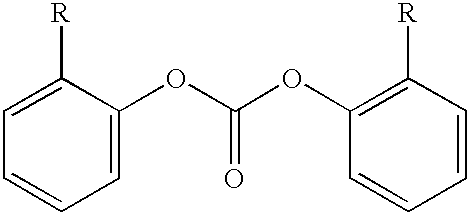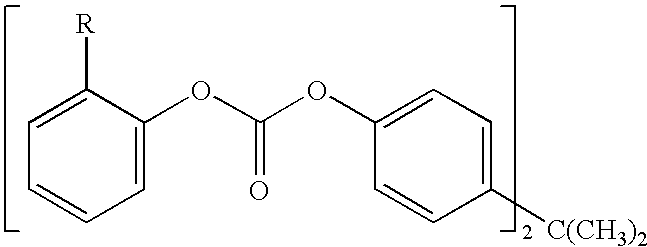Method for end-capping polycarbonate resins and composition for use in same
a polycarbonate resin and composition technology, applied in the field of end-capping polycarbonate resins and end-capping compositions, can solve the problems of limiting the reaction kinetics and thus achievable molar mass and end-cap level, requiring considerably different equipment and operating conditions for replacement of dpc by these compounds, and achieves improved thermal stability, reduced water up-take, and reduced free-hydroxyl endgroups
- Summary
- Abstract
- Description
- Claims
- Application Information
AI Technical Summary
Benefits of technology
Problems solved by technology
Method used
Image
Examples
example 2
Example 1 was repeated but instead of nonylphenol 0.1833 g (ratio endcapper to free-OH=0.5) dodecylphenol and 0.2307 g (ratio endcapper to free-OH=0.5) bis-(methyl salicyl) carbonate was used. As summarized in Table 2, the endcap ratio of the sample polycarbonate was increased from 52.1% to 83.0% and 0.42 mole percentage of the dodecylphenol was incorporated in the polymer product.
example 3
Example 1 was repeated but instead of nonylphenol 0.2127 g (ratio endcapper to free-OH=0.5) meta-pentadecylphenol and 0.2307 g (ratio endcapper to free-OH=0.5) bis-(methyl salicyl) carbonate was used. As summarized in Table 2, the endcap ratio of the sample polycarbonate was increased from 52.1% to 80.9% and 0.44 mole percentage of the meta-pentadecylphenol was incorporated in the polymer product.
example 4
In this example, a continuous reaction system was used. The apparatus consists of one monomer mix agitation tank, two pre-polymerization tanks and one horizontally agitated polymerization tank. Bisphenol A and diphenyl carbonate in a molar ratio of 1.08:1 were continuously supplied to a heated agitation tank where a uniform solution was produced. About 250 eq (2.5*10.sup.-4 mol / mol bisphenol A) tetramethylammonium hydroxide and 1 eq (1.10.sup.-6 mol / mol bisphenol A) of NaOH were added to the solution as catalysts in the first pre-polymerization tank. The solution was then successively supplied to the next pre-polymerization tank and the horizontally agitated polymerization tank, arranged in sequence, and the polycondensation was allowed to proceed to produce a starting polymer "B" emerging from the outlet stream of the second pre-polymerization tank for Example 4 with a Mw of 4150 g / mol, an Mn of 2730 g / mol, and an endcap level of about 49%.
For example 4, a 2:1 molar ratio of bis-(m...
PUM
| Property | Measurement | Unit |
|---|---|---|
| glass transition temperature | aaaaa | aaaaa |
| mol % | aaaaa | aaaaa |
| glass transition temperatures | aaaaa | aaaaa |
Abstract
Description
Claims
Application Information
 Login to View More
Login to View More - R&D
- Intellectual Property
- Life Sciences
- Materials
- Tech Scout
- Unparalleled Data Quality
- Higher Quality Content
- 60% Fewer Hallucinations
Browse by: Latest US Patents, China's latest patents, Technical Efficacy Thesaurus, Application Domain, Technology Topic, Popular Technical Reports.
© 2025 PatSnap. All rights reserved.Legal|Privacy policy|Modern Slavery Act Transparency Statement|Sitemap|About US| Contact US: help@patsnap.com



